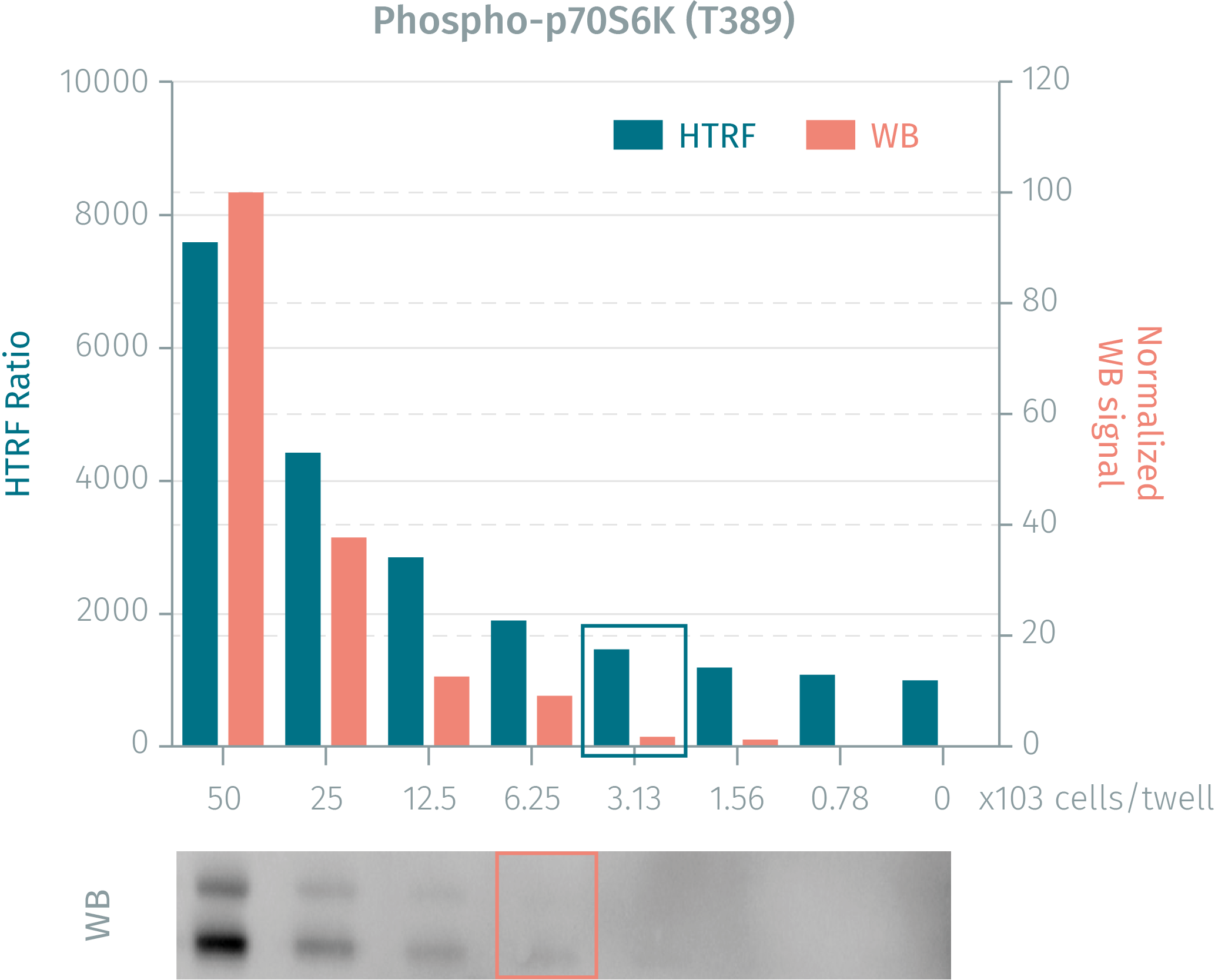

HTRF Human and Mouse Phospho-P70S6K (Thr389) Detection Kit, 10,000 Assay Points






The phospho-P70S6K (Thr389) kit enables the cell-based quantitative detection of phosphorylated P70S6K at Thr389 as a readout of mTOR signaling.
For research use only. Not for use in diagnostic procedures. All products to be used in accordance with applicable laws and regulations including without limitation, consumption & disposal requirements under European REACH regulations (EC 1907/2006).
Product information
Overview
This HTRF cell based assay conveniently and accurately quantifies phosphorylated p70S6K at Thr389. Compatible with most cell types, this kit is the perfect tool for screening and studying compounds biologically impacting cell proliferation, survival, invasion, motility, and insulin receptor signaling. The kit has applications in oncology, metabolism (diabetes, obesity, aging), cardiovascular diseases, and neurodegenerative diseases.
Specifications
| Assay Points |
10000
|
|---|---|
| Assay Target Type |
Kit
|
| Assay Technology |
HTRF
|
| Brand |
HTRF
|
| Quantity |
1
|
| Therapeutic Area |
Metabolism/Diabetes
Neuroscience
|
| Unit Size |
10,000 Assay Points
|
Video gallery


How it works
Phospho-p70S6K (Thr389) assay principle
The Phospho-p70S6K (Thr389) assay measures p70S6K when phosphorylated at Thr389. Contrary to Western Blot, the assay is entirely plate-based and does not require gels, electrophoresis or transfer. The Phospho-p70S6K (Thr389) assay uses 2 labeled antibodies: one with a donor fluorophore, the other one with an acceptor. The first antibody is selected for its specific binding to the phosphorylated motif on the protein, the second for its ability to recognize the protein independent of its phosphorylation state. Protein phosphorylation enables an immune-complex formation involving both labeled antibodies and which brings the donor fluorophore into close proximity to the acceptor, thereby generating a FRET signal. Its intensity is directly proportional to the concentration of phosphorylated protein present in the sample, and provides a means of assessing the proteins phosphorylation state under a no-wash assay format.

Phospho-p70S6K (Thr389) 2-plate assay protocol
The 2 plate protocol involves culturing cells in a 96-well plate before lysis then transferring lysates to a 384-well low volume detection plate before adding phospho-p70S6K (Thr389) HTRF detection reagents. This protocol enables the cells' viability and confluence to be monitored.

Phospho-p70S6K (Thr389) 1-plate assay protocol
Detection of Phosphorylated p70S6K (Thr389) with HTRF reagents can be performed in a single plate used for culturing, stimulation and lysis. No washing steps are required. This HTS designed protocol enables miniaturization while maintaining robust HTRF quality.

Assay validation
HTRF assay compared to WB using phospho-p70S6K cellular assay
Human HEK293 cells were grown in a T175 flask at 37°C, 5% CO2, for 1 day. At day2, after removal of cell culture medium, 3ml of supplemented lysis buffer were added and incubated for 30 minutes. Soluble supernatants were collected after a 10 minute centrifugation. Equal amounts of lysates were used for a side by side comparison of Western Blot and HTRF.3000 cells can be detected by using HTRF phospho-P70S6K (Thr389) whereas 6000 cells are needed for the Western Blot. The phospho-p70S6K HTRF assay is two-fold more sensitive than the WB.

Pharmacological response: agonist and antagonist action modes
Human HEK293 cells (100,000 cells/well) were incubated with two concentrations of the inhibitors indicated, Wortmanin and LY294002, followed by stimulation with 1.0 µM of Insulin for 30 minutes at 37°C. After 30 minutes of lysis incubation, phosphorylated P70S6K was measured using the two-plate assay protocol

Rapamycin inhibition on stimulated NIH3T3 cells
Murine NIH3T3 cells (100,000 / 50,000 / 25,000 cells/well) were incubated for 3 hours with varying concentrations of Rapamycin inhibitor, followed by stimulation with 1.0 µM of Insulin for 30 minutes at 37°C. After 30 minutes of lysis incubation, inhibition of P70S6K phosphorylation was measured using the HTRF phospho-P70S6K (Thr389) assay with two-plate protocol.

Simplified pathway
Phospho-p70S6K (Thr389) simplified pathway
P70S6K is a pro-survival factor which belongs to the family of serine/threonine protein kinases. P70S6K acts downstream of the mammalian target of Rapamycin (mTOR), and is crucial for the regulation of cell growth, proliferation, survival and migration by its signaling to several important downstream effectors, e.g. S6RP, elF4B and eEF2K, which induces protein synthesis. P70S6K has multiple functions: it is also involved in insulin receptor signaling by regulating the insulin substrate (IRS1), and has a survival effect by negatively regulating apoptosis via its control of the pro-apoptotic protein, Bad.

Resources
This guide provides you an overview of HTRF applications in several therapeutic areas.

SDS, COAs, Manuals and more
Are you looking for technical documents for this product. We have housed them in a dedicated section., click on the links below to explore.


How can we help you?
We are here to answer your questions.






























